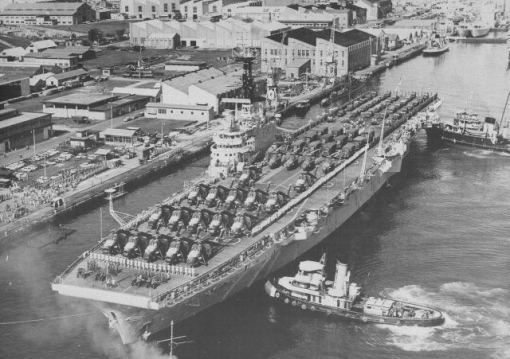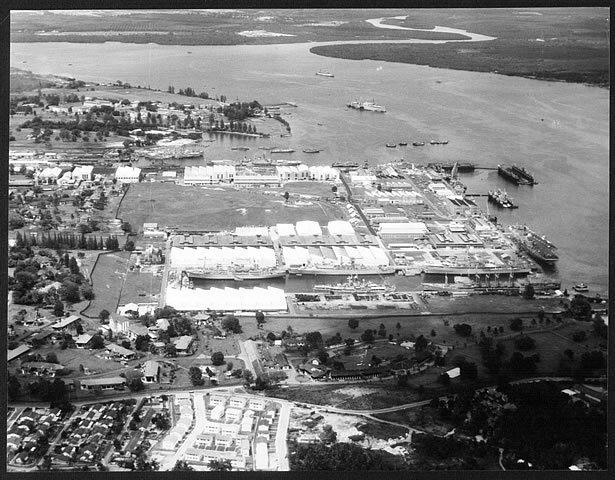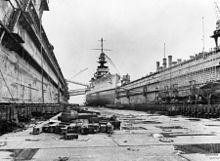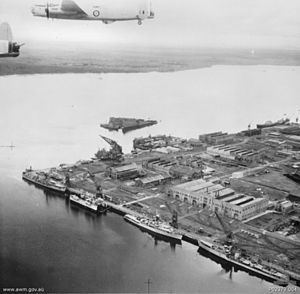 | ||
Singapore naval base opened 1938
Her Majesty's Naval Base, Singapore (also His Majesty's Naval Base, Singapore; HMNB Singapore), alternatively known as Singapore Naval Base, Sembawang Naval Base and HMS Sembawang, was situated in Sembawang at the northern tip of Singapore and was both a Royal Navy shore establishment and a cornerstone of British defence policy (the Singapore strategy) in the Far East between the World Wars.
Contents
- Singapore naval base opened 1938
- Singapore naval base open house
- History
- Continued Commonwealth presence
- American presence
- Access to Indian Navy ships
- Admiralty IX Floating Dry Dock
- King George VI Graving Dock
- References

Singapore naval base open house
History

After the Great War, the British government devoted significant resources into building a naval base in Singapore, as a deterrent to the increasingly ambitious Japanese Empire.

Originally announced in 1923, the construction of the base proceeded slowly at Sembawang until the Japanese invasion of Manchuria in 1931. It was completed in 1939, at a staggering cost of £60 million – equivalent to £2½ billion in 2006. The base covered 21 square miles (54 km2) and had what was then the largest dry dock in the world, the third-largest floating dock, and enough fuel tanks to support the entire British Navy for six months.

It was defended by heavy 15-inch naval guns stationed at Johore battery, Changi, and at Buona Vista Battery. Other important batteries of smaller calibre were located at Fort Siloso, Fort Canning, and Labrador. Air defence relied on the Royal Air Force airfields at RAF Tengah and RAF Sembawang.
Winston Churchill touted it as the "Gibraltar of the East".
After the fall of Malaya on 31 January 1942, Singapore came within range of the artillery guns of Imperial Japanese Twenty-fifth Army positioned within sight of the base in Johor, which was poised to capture Singapore within 2 weeks. The base was subsequently captured, largely intact, by units of the advancing Japanese Army and remained in Japanese control through the end of World War II.
With the surrender of Japan in August 1945, control of the naval base and Singapore was reverted to British and Commonwealth Forces in September 1945, when allied units of South East Asia Command under Lord Louis Mountbatten started to arrive in Singapore.
In line with Royal Navy's tradition of naming their respective Naval base and dockyard, the accommodation barracks adjacent to the base became known as HMS Terror (from 1945 to 1971) in honour of HMS Terror, an Erebus-class monitor armed with twin 15-inch guns, which was based at one time in Singapore before the war. Since 1972, part of the compound is now occupied by the Republic of Singapore Navy's Naval Diving Unit (NDU).
Continued Commonwealth presence
With the complete withdrawal of British forces from Singapore in 1971, the Naval Base has since been handed over to the Singapore government, which in 1968 converted it into a commercial dockyard (as Sembawang Shipyard, now part of Singapore Exchange-listed SembCorp Marine).
After the short term ANZUK arrangement was terminated (started in 1971 and ended in 1974), New Zealand Force South East Asia (NZFORSEA) was created with the HQ being sited at the Stores Basin area adjacent to the current Sembawang Naval Basin. NZFORSEA consisted of 1 Royal New Zealand Infantry Regiment (RNZIR), which was based at Dieppe Barracks near Yishun New Town, No. 141 Flight of Royal New Zealand Air Force (RNZAF), with its Bell UH-1D/H Hueys based at Sembawang Air Base and frequent deployments of Royal New Zealand Navy (RNZN) frigates. It should be noted this was the last major foreign military presence based in Singapore. Total military strength at the time stood at 850 with some 700 dependents. Under the auspices of the Five Power Defence Arrangements (FPDA), NZFORSEA took over the Royal Navy married quarters and billets, while the Installations Auxiliary Police Force (IAPF) was formed, the small police force was staffed by Singaporeans but commanded by an NZ officer to provide security to the whole area. This security blanket covered the British, UK and Australian facilities and personnel. When NZFORSEA withdrew from Singapore in 1989, it was replaced by the smaller NZ Defence Support Unit, the South East Asia (NZDSU SEA), with the IAPF still providing security to other nations including the US facilities and personnel.
However, the British Ministry of Defence (MoD) continues to maintain a small logistics base at Sembawang wharf to control most of the foreign military activities there, which includes repair, refuel and resupply for ships of the Australian, British and New Zealand navies as well as those from other Commonwealth countries under the auspices of FPDA.
American presence
As part of a 1990 agreement (concluded in 1992) between Singapore and the United States, American military forces (primarily naval and air force) have been making use of Sembawang's base facilities. The Task Force 73/Commander, Logistics Group Western Pacific has been headquartered in Sembawang since 1992, providing logistic support for the US 7th Fleet in its operations in the Pacific and Southeast Asia.
Apart from the US naval presence, the United States Air Force has its administration, logistics and support component for the 497th Combat Training Squadron being based there, while the squadron's flight operations are based out of Paya Lebar Air Base.
Access to Indian Navy ships
Since 2002, Singapore has granted the Indian Navy in principle access to Sembawang Port and Indian patrol boats escorting American Naval ships through the straights of Malacca.
Admiralty IX Floating Dry Dock
A large floating dry dock, the third-largest in the world at the time of its construction, was located at the base.
King George VI Graving Dock
The graving dock was completed in February 1938 and was more than 300 meters in length and was the largest dry dock in the world at the time. With the impending capture of Singapore by the Imperial Japanese Army in 1942, the dry dock gates were blown off and machinery destroyed. The dock was subsequently repaired and used throughout the war and was subjected to Allied air attacks to disable the dry dock in late 1944 and early 1945.
